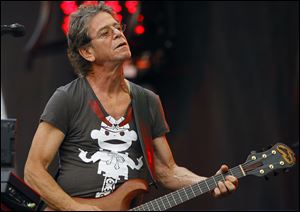
APPRECIATION
Reed’s dark artistic vision had major influence on rock
10/28/2013
Shown performing in 2009 at the Lollapalooza music festival in Chicago, punk poet and rock legend Lou Reed died Sunday of a liver-related ailment. He was 71.
Lou Reed, who died Sunday in Southampton, N.Y., at 71 of complications from a liver transplant he received in May, epitomized intellectual musicality, gender ambiguity, and hedonistic excess of New York City in the 1960s as a member of the Velvet Underground. He became a hugely influential giant for the next 50 years.
Reed was living in Manhattan when he met Welsh musician John Cale in the ’60s. The two became roommates in New York’s gritty Lower East Side and formed the nucleus of a group that would evolve into the Velvet Underground.
Reed had already begun working on his signature guitar sound by tuning all the strings on his instrument to the same note, and had composed the song “Heroin,” which would appear on the Velvets’ 1967 debut album, “The Velvet Underground and Nico.” The album, with its starkly unforgettable Andy Warhol cover design of a garishly yellow banana, also included the song “I’m Waiting for the Man,” a kind pre-punk chant about a drug hookup.
By that time, Warhol had taken the band under his wing as part of his disparate band of musicians, models, photographers, filmmakers, painters, transvestites, and uncategorizible figures from New York’s fringes of respectable society. Even before the album appeared, the Velvets were the house band for Warhol’s Exploding Plastic Inevitable, multimedia happenings Warhold organized in New York and elsewhere.
By 1969, Cale had left the band and Reed was a year away from launching his own solo career when the Velvets went to San Francisco to play the Matrix. Tapes from those performances, as well as a Dallas date, were later used to make one of the band’s most popular albums, “1969: The Velvet Underground Live,” released in 1974.
The Matrix gig delineated the enormous musical and intellectual gap between California and New York Rock in the ’60s. Where the San Francisco sound was epitomized by groups like Jefferson Airplane, the Grateful Dead, Big Brother and the Holding Company, and Santana — a kind of neo-baroque, psychedelic-influenced musicality — the Velvets and other New York bands probed darker themes, and were known for a deceptively sparse musicality which would later influence punk rock.
Reed was born in Brooklyn on March 2, 1942 to an accountant Sidney Reed and his wife, Toby, and grew up in Long Island. In 1956, his parents arranged for him to undergo electroshock therapy in an attempt to “cure” him of being bisexual. Reed later repurposed the experience in the song “Kill Your Sons.”
He moved to Manhattan after graduating from Syracuse University in in 1964.
Reed left the Velvet Underground in 1970, but it was more difficult for him to leave some of the trappings of that life — chiefly, drug and alcohol abuse. He wouldn’t get clean until the 1980s, but still managed a prodigious musical and literary output during that time.
His second solo album, 1972’s “Transformer,” was a commercial success and included his hit song “Walk on the Wild Side,” memorializing such figures of Warhol’s the Factory as transvestites Holly Woodlawn, Jackie Curtis, and Candy Darling. Even if they didn’t get the references, millions of music lovers were hooked by the loping bass lines and the song remains instantly recognizable today.
Reed remained artistically adventurous and collaborative throughout his long and rich career. He played bass for Roy Orbison in concert, contributed vocals on a Gorillaz album, and performed “Sweet Jane” and “White Light/White Heat” live with Metallica at Madison Square Garden in 2009. Two years later, Reed and the Bay Area metal band would team up for the album, “Lulu.”
Reed published his first book of photographs in 2003, entited Emotions in Action. His writings were also published in the New Yorker. He was the subject of an American Masters documentary and was inducted into the Rock and Roll Hall of Fame in 1996.
Reed is likely to be remembered for his one Top 20 hit, “Walk on the Wild Side,” but that doesn’t begin to summarize the extraordinary artistic vision and immeasurable influence of his art. Whatever we think of as indie or alt rock today would not exist without Reed’s influence.